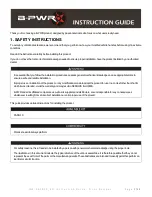
ISO-OXY-2/OXELP
World Precision Instruments
5
OPERATING INSTRUCTIONS
TIP
: Refer to your free radical analyzer manual for proper grounding and shielding
techniques. (In the
TBR4100/TBR1025
manuals, see “Grounding and Noise
Concerns” in the Operating Instructions section.)
Polarizing the Sensor
1. Place the sensor in 0.1M PBS solution
2. Plug it into the monitoring device.
3. Turn on the monitoring device.
4. If necessary, set the poise voltage. On the TBR4100/1025 set the
Probe Select
switch to
O2
, on the Apollo1000 set the poise voltage to +700mV.
5. Set the range to 100nA.
6. The sensor should be allowed at least one hour to reach a stable baseline current
of 16-80nA before it is used for measurement.
7. If the stabilized baseline value exceeds 80nA, see “Replacing the Membrane
Sleeve” on page 10.
NOTE
: This polarization procedure assumes the temperature is 25ºC. At 37ºC the
baseline current is higher.
Calibration Procedure
The oxygen sensor (in combination with a monitoring device) amperometrically
measures the concentration of oxygen in aqueous solutions and can be used short
term (2 hours or less) in a gas mixture.
Once the sensor is polarized, It can be calibrated. The polarized sensor should already
be immersed in filling solution and plugged into the monitoring device. The following
example briefly describes the fundamental concepts behind a standard calibration
protocol. Known concentrations of O
2
are generated by saturating the solution with
oxygen (100%) and nitrogen (0%). Dry air or a solution saturated with air has a 20.8%
concentration of oxygen. Using these three known points, a calibration curve can be
generated.
NOTE
: For additional sensor calibration procedures and calibration theory, refer to
the free radical analyzer manual. Most WPI manuals can be downloaded directly from
www.wpiinc.com. This information can also be e-mailed when you contact the WPI
Technical Support team at 941.371.1003 or [email protected].
NOTE
: For accurate results the sensor must be calibrated at the same temperature
expected at the measurement site.






































